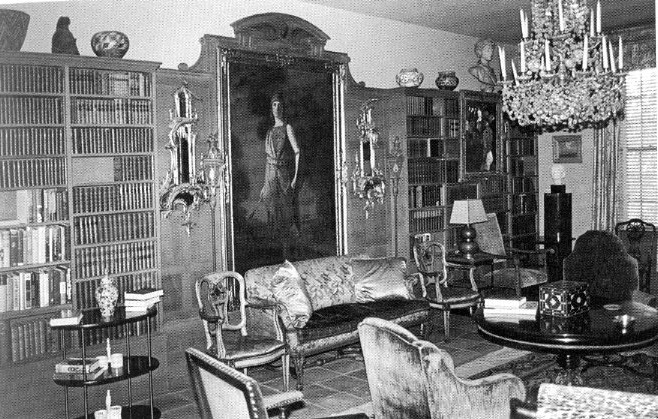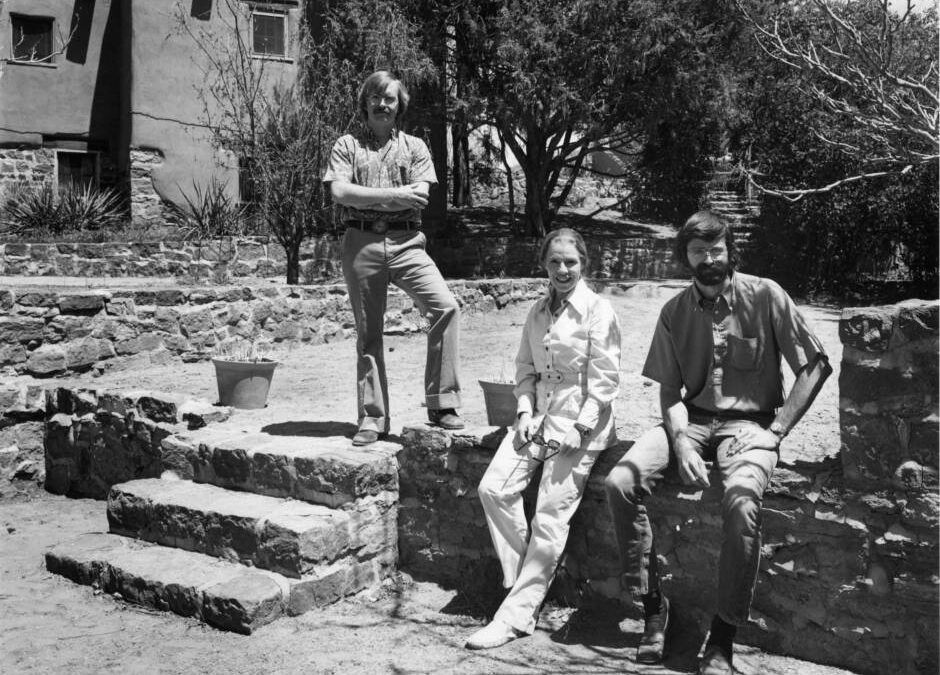The first three Weatherhead resident scholar fellows on the new campus of the School of American Research in 1974. Left to right: Edwin L. Wade (1973-5), Joann W. Kealiinohomoku (1974-5), Earl Wesley Jernigan (1974-6). Photo courtesy of the School for Advanced Research.
In celebration of fifty years of Resident Scholars at the School for Advanced Research (SAR), we will share a series of posts about the program and the scholars over the years.
At the beginning, there were three because that was what space and funding allowed. In addition to the need for more fellowships, a great deal of repair and upgrade was necessary before there could be a full slate of resident scholars.
Six was the ideal number of resident fellows in SAR Director Douglas Schwartz’s mind. It wasn’t until ten years later in 1984, after archaeologist Marjorie Lambert sold the Jack Lambert House to SAR, after considerable campus renovation, and once the National Endowment for the Humanities (NEH) and Katrin H. Lamon fellowships began, that this vision could be realized.
“If it was a larger group, you wouldn’t have the intense interaction between the scholars. . . . The opportunity to interact with other bright scholars in an area different from their own stimulates their thinking, broadens their perspective about what they are doing. Keeping that number to six or seven allowed them to be a strong, interactive group,” reflected Schwartz many years later.
The first three Resident Scholars, all Weatherhead Fellows, were introduced in the Santa Fe New Mexican in September 1974: Edwin L. Wade, Joann Wheeler Kealiinohomoku, and Earl Wesley Jernigan.
Although not publicly announced, Edwin L. Wade was quietly in residence at SAR starting in October 1973. Given that his doctoral dissertation was on the economics of the Santa Fe Indian Market, perhaps Wade arrived early to get to work right away, joining the other scholars officially the next year.
Wade wrote The History of the Southwest Indian Ethnic Art Market as his PhD dissertation for the University of Washington while at SAR, and it was published in 1976. In 1975, he accepted a summer teaching position at Harvard University. Wade has written at least nine books and curated two traveling Native American art exhibits. Executive editor of Arts of the North American Indian: Traditions in Evolution (Hudson Hills Press: 1995), Wade published The Call of Beauty: Masterworks by Nampeyo of Hopi with Allan R. Cooke in 2022. He currently lives with his wife, Carol Haralson, an award-winning book editor and designer, in Sedona, Arizona.
Joann Wheeler Kealiinohomoku was SAR’s first female Resident Scholar. Affiliated with the University of Hawaii when she came to SAR as a Weatherhead Fellow from 1974-1975, Kealiinohomoku received her doctorate from Indiana University in 1976 with the dissertation “Theory and Methods of the Anthropological Study of Dance.” Her project at SAR was titled “The Ethnology of Hopi-Tewa Dance.” There is no record that either became a book. Kealiinohomoku co-founded the organization Cross-Cultural Dance Resources (CCDR) in 1981, which President Bill Clinton designated for preservation under the Save America’s Treasures program. For many years, she was an associate professor of anthropology at Northern Arizona University. In 1997, she received the first annual award for Outstanding Contribution to Dance Research from the Congress on Research in Dance. Kealiinohomoku passed away on December 2, 2015 at the age of 85.
Kealiinohomoku arrived at SAR with her daughter, Halla, who attended a local Junior High School. Wes Jernigan remembers that Joann “was energetic, bright, and a personable lady.”
Earl Wesley Jernigan, or Wes as he prefers, was the third of the first group of Weatherhead Fellows at SAR. He stayed for two years, working in residence from the fall of 1974 until the spring of 1976.
While studying at the University of Kentucky, Jernigan saw a flyer inviting scholars to apply to SAR for a resident program. Jernigan contacted Douglas Schwartz and said, “If you let me come and live in Santa Fe, I’ll write a book about anything you’d like.” Schwartz filled him in about the Resident Scholar Program, and Jernigan packed his car and brought his wife and two young sons to SAR.

The New York Room of Amelia Elizabeth White and her sister Martha White became the library for resident scholar fellows in the first decades of the program. Today it is the Wagner scholar residence. Featured amidst the books is Martha White as an Amazonian warrior queen from Greek mythology in her painted senior portrait from Bryn Mawr in 1903. Photo courtesy of the SAR.
True to his word, while at SAR Jernigan wrote Jewelry of the Prehistoric Southwest, which was published by SAR Press in 1978. Jernigan says he still sees it on the bookshelves of his colleagues. Jernigan later taught in the Art Department at the University of Arizona and as a professor at Eastern Arizona College, chairing the Anthropology Department until his retirement in 2002.
Remembering his arrival at the SAR campus, Jernigan said everything was ready to go when they arrived. It was “as though the place had been built for us.”
He doesn’t remember a swimming pool, however, the tennis court received frequent use after he and assistant to the director David Grant Noble restored it by removing a forest of weeds and plants. Jernigan’s little son Marcus regretted climbing up one of the apricot trees when he couldn’t get back down. And SAR Director Douglas Schwartz set Jernigan to work mending the shutters on the south side of the main “El Delirio” house, now SAR’s Administration Building.
NEXT WEEK: A poet anthropology couple who were each resident scholars in two different decades of the program
Sources:
“Dr. Earl Wesley Jernigan named as SAR Weatherhead resident scholar. The Santa Fe New Mexican. July 23, 1974.
Interview with Wes Jernigan, April 22, 2024.
Interview with David Grant Noble, April 25, 2024.
Interview with Nita Schwartz, April 23, 2024.
Lewis, Nancy Owen and Hagan, Kay Leigh. A Peculiar Alchemy. 2007: School for Advanced Research Press.
“School of American Research plans reception on Sunday.” The Santa Fe New Mexican. September 12, 1974.
“Weatherhead Scholar, specialist in dance, in residence at SAR.” The Santa Fe New Mexican. September 12, 1974.
